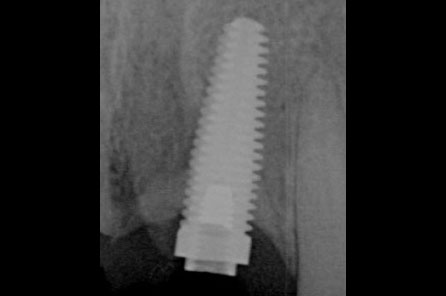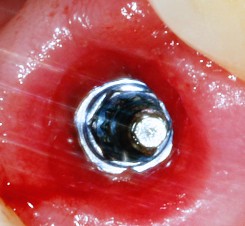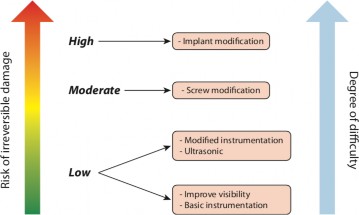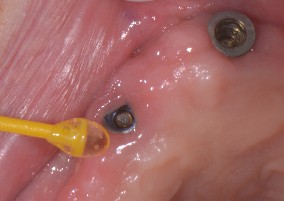
Fractured Implant Abutment Screws
… And What To Do When It Happens
By William Wilson, Jr., DDS, MS
 How many patients call you to schedule an appointment knowing they are going to break a restoration or tooth a week in advance? Never happens. Right? Patients don’t plan to break restorations, components, have pain, etc. They just show up at your door on Monday morning and wreak havoc on your schedule. Knowing how to deal with these problems quickly when they happen is the key to making your schedule run smoother and keep your patients, your staff, and you less stressed.
How many patients call you to schedule an appointment knowing they are going to break a restoration or tooth a week in advance? Never happens. Right? Patients don’t plan to break restorations, components, have pain, etc. They just show up at your door on Monday morning and wreak havoc on your schedule. Knowing how to deal with these problems quickly when they happen is the key to making your schedule run smoother and keep your patients, your staff, and you less stressed.
Dental implants continue to be an excellent option to restore the function of a missing tooth, but mechanical complications, such as abutment screw loosening or fracture have been reported. The fracture of implant abutment screws have been reported to be as high as 8%. Now, 8% might not sound like too much of a problem, but if you only restored 100 implants a year you would expect to see as many as 8 abutment screw fractures a year. That’s a lot of stressful Monday mornings.
 How difficult the removal of the fractured screw fragment will be depends on a few factors. The material the screw is made of is one of these. I find gold alloy screws or screws with a dry lubricant to be easier to remove than those made of titanium. Having dissimilar materials reduces the frictional coefficient and make these materials less likely to “cold-weld”, so choose your delivery screws wisely. Another factor is the level of the screw fracture. Typically screws will break at the contact with the first internal thread. This means that the deeper into the implant before you see contact with the first internal thread the more difficult removing fractured screw fragments will be. With this in mind, external hex implants will typically prove less difficult to remove fractured implant fragments that those with internal connections and deep first internal threads. Keep this in mind when selecting a dental implant restorative connection.
How difficult the removal of the fractured screw fragment will be depends on a few factors. The material the screw is made of is one of these. I find gold alloy screws or screws with a dry lubricant to be easier to remove than those made of titanium. Having dissimilar materials reduces the frictional coefficient and make these materials less likely to “cold-weld”, so choose your delivery screws wisely. Another factor is the level of the screw fracture. Typically screws will break at the contact with the first internal thread. This means that the deeper into the implant before you see contact with the first internal thread the more difficult removing fractured screw fragments will be. With this in mind, external hex implants will typically prove less difficult to remove fractured implant fragments that those with internal connections and deep first internal threads. Keep this in mind when selecting a dental implant restorative connection.
Fractured abutment screws must be removed, or the dental implant may prove useless and need to be replaced. More than 30 techniques for managing fractured prosthetic or abutment screws have been published. These techniques have varying levels of risk to the implants and damage may be irreversible. It is recommended to always begin with low risk techniques first and cautiously move on to higher risk techniques only when necessary and only after extreme patience with lower risk techniques have been exhausted without success.
In a systematic review published in the April 2018, Journal of Prosthetic Dentistry, Mizumoto, et al. described the risk of irreversible implant damage and its direct relationship to the screw fragment retrieval technique.
 After an accurate diagnosis, an assessment of the risk, and a plan for screw fragment retrieval has been made, first attempts might be made with an explorer tine in direct contact with the retained fragment with movement in a counter
After an accurate diagnosis, an assessment of the risk, and a plan for screw fragment retrieval has been made, first attempts might be made with an explorer tine in direct contact with the retained fragment with movement in a counter
clock-wise direction. Make sure you are moving the screw in the desired direction and not making things worse. If after several minutes you are not seeing any movement try to ascertain why. The next step is to try and get movement of the screw fragment with ultrasonic instrumentation, but pay close attention and make sure you are moving the screw fragment in the desired direction and not making things worse.
Both of these techniques are relatively low risk. If not successful with any of the low risk techniques you may decide to move to a moderate risk technique. Because the risk is now increasing move cautiously and only with excellent visibility. Moderate risk techniques involve using a 1/4 or 1/2 round bur at very slow speeds in reverse being sure you are making contact only with the screw fragment and not touching the internal threads of the implant in any way. Damage to the internal threads may make your efforts useless even if you manage to retrieve the screw fragment. If none of these techniques are successful, and only when you are sure there is no more hope, there is an option to attempt to grind away the retained screw fragment and re-tap the dental implant internal threads. This should be all but a last resort, and after long and careful consideration, as the options after this become less desirable.
 With implants that have an internal connection design, you may back the screw all the way out of the threads and still be unable to retrieve the screw because it is so deep due to the implant connection design. I have found a dental restoration holder (The plastic sticks with adhesive on the tip) to be helpful in grabbing those loose fragments in the deeper connections.
With implants that have an internal connection design, you may back the screw all the way out of the threads and still be unable to retrieve the screw because it is so deep due to the implant connection design. I have found a dental restoration holder (The plastic sticks with adhesive on the tip) to be helpful in grabbing those loose fragments in the deeper connections.
Screws fracture when they have been overloaded and a loss of pre-load has occurred. Loose screws lead to fractured screws if not managed expeditiously. All patients that have been restored with dental implants should be reminded to return to your office if they sense any movement of their implant supported restorations. As with most things, early intervention can often prevent more advanced problems.

Comments closed
No comments. Leave first!